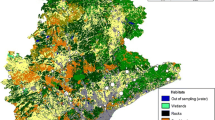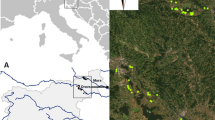Abstract
To help determine the major factors associated with alien plant in a newly invaded mountain range; we analyzed the distribution patterns of woody alien species along the altitudinal gradient of the Córdoba mountains, in relation to biotic, abiotic and anthropogenic factors. We selected 303 plots using a Geographic Information System (GIS) covering all the variability of these factors. In the field we registered woody alien occurrence in these 303 and in 303 additional neighbor plots. We used 12 biotic, abiotic and anthropogenic variables from the GIS to predict the probability of presence of alien species through a logistic model. Then, we analyzed if neighbor alien occurrences could explain some additional variance. We created a probability map with 4 categories of alien occurrence which was then validated by new field sampling. Occurrence of woody aliens was highest in the eastern slope (with longer history of species introduction), at low altitudes, near sources of propagule pressure (human settlements, roads and neighbor sites with established alien plants), and associated to sheltered topographies. In the upper belt of the Córdoba Mountains woody invasion is incipient and thus in a transient stage. Accordingly, propagule pressure seems to be the major factor at play, while the relevance of disturbance and biotic interactions is less clear.



Similar content being viewed by others
References
Afifi AA, Clark V (1984) Computer-aided multivariate statistics. Wadsworth inc, Belmont
Alexander JM, Naylor B, Poll M, Edwards PJ, Dietz H (2009) Plant invasions along mountain roads: the altitudinal amplitude of alien Asteraceae forbs in their native and introduced ranges. Ecography 32:334–344
Becker T, Dietz H, Billeter R, Buschmann H, Edwards PJ (2005) Altitudinal distribution of alien plant species in the Swiss Alps. Perspect Plant Ecol 7:173–183
Cabido M, Acosta A (1985) Estudio fitosociológico en bosques de Polylepis australis BITT. (“Tabaquillo”) en las sierras de Córdoba. Argentina. Doc Phytosoc 9:385–400
Cantero JJ, Liira J, Cisneros JM, Gonzales J, Nuñez C, Petryna L, Cholaky C, Zobel M (2003) Species richness, alien species and plant traits in Central Argentine mountain grasslands. J Veg Sci 14:129–146
Capitanelli J (1979) Clima. In: Vazquez J, Miatello R, Roque M (ed) Geografía Física de la Provincia de Córdoba. Buenos Aires, pp 45–138
Charles H, Dukes JS (2007) Impacts of invasive species on ecosystem services. In: Nentwig W (ed) Biological invasions. Springer, Berlin, pp 217–237
Cingolani AM, Cabido MR, Renison D, Solís Neffa V (2003) Combined effects of environment and grazing on vegetation structure in Argentine granite grasslands. J Veg Sci 14:223–232
Cingolani AM, Renison D, Tecco PA, Gurvich DE, Cabido M (2008) Predicting cover types in a mountain range with long evolutionary grazing history: a GIS approach. J Biogeogr 35:538–551
Cingolani AM, Renison D, Zak MR, Cabido MR (2004) Mapping vegetation in a heterogeneous mountain rangeland using landsat data: an alternative method to define and classify land-cover units. Rem Sens Env 92:84–97
Colladon L, Felici GG, Plazos I (2009) Anuario pluviométrico 2000/01–2004/05. Síntesis 1992/93–2004/05. Cuenca del río San Antonio. Sistema del río Suquia-provincia de Córdoba. Instituto Nacional del Agua (INA), Centro de la Región Semiárida (CRSA)
Cronk QCB, Fuller JL (1995) Plant invaders, the threat to natural ecosystems, 1st edn. Chapman and Hall, London
Daehler CC (2005) Upper-montane plant invasions in the Hawaiian Islands: patterns and opportunities. Perspect Plant Ecol 7:203–216
De Pietri D (1992) Alien shrubs in a national park: can they help in the recovery of natural degraded forest? Biol Conserv 62:127–130
Díaz S, Acosta A, Cabido M (1994) Community structure in montane grasslands of central Argentina in relation to land use. J Veg Sci 5:483–488
Dietz H (2005) A mountain invasions special issue. Perspect Plant Ecol 7:135–136
Dietz H, Edwards PJ (2006) Recognition that causal processes change during plant invasion helps explain conflicts in evidence. Ecology 87:1359–1367
ERDAS (1995) ERDAS field guide, 3rd edn. ERDAS Inc, Atlanta
Farley KA, Jobbágy EG, Jackson RB (2005) Effects of afforestation on water yield: a global synthesis with implications for policy. Global Change Biol 11:1565–1576
Freytes de Vilanova M (2006) Aquí me quedo! Historia de Villa General Belgrano. El Copista
Holmes PM, Cowling RM (1997) The effects of invasion by Acacia saligna on the guild structure and regeneration. J Appl Ecol 34:317–332
Hoyos L, Gavier-Pizarro GI, Kuemmerle T, Bucher EH, Radeloff VC, Tecco PA (in press) Invasion of glossy privet (Ligustrum lucidum) and native forest loss in the Sierras Chicas of Córdoba, Argentina. Biol. Invasions. doi:10.1007/s10530-010-9720-0
Körner CH (1999) Alpine plant life. Functional plant ecology of high mountain ecosystems Ed. Springer, Berlin, pp 343
Körner CH, Paulsen J (2004) A world-wide study of high altitude treeline temperatures. J Biogeogr 31:713–732
Le Maitre DC, Van Wilgen BW, Chapman RA, McKelly DH (1996) Invasive plants and water resources in the Western Cape Province, South Africa: modelling the consequences of a lack of management. J Appl Ecol 33:161–172
Le Maitre DC, van Wilgena BW, Gelderbloma CM, Baileyb C, Chapmana RA, Nela JA (2002) Invasive alien trees and water resources in South Africa: case studies of the costs and benefits of management. For Ecol Manage 160:143–159
Mack RN, Simberloff D, Londsdale WM, Evans H, Clout M, Bazzaz FA (2000) Biotic invasions: causes, epidemiology, global consequences, and control. Ecol Appl 103:689–710
Marcora P, Hensen I, Renison D, Seltmann P, Wesche K (2008) The performance of Polylepis australis trees along their entire altitudinal range: implications of climate change for their conservation. Div Distrib 14:630–636
Millennium Ecosystem Assessment (2005) Ecosystems and human well-being: synthesis. Island Press, Washington
Morales CL, Aizen MA (2002) Does invasion of exotic plants promote invasion of exotic flower visitors? A case study from the temperate forests of the southern Andes. Biol Invasions 4:87–100
Paiaro V, Cabido M, Pucheta E (in press) Altitudinal distribution of native and alien plant species in roadside communities from central Argentina. Austral Ecol. doi: 10.1111/j.1442-9993.2010.02134.x
Paiaro V, Mangeaud A, Pucheta E (2007) Alien seedling recruitment as a response to altitude and soil disturbance in the mountain grasslands of central Argentina. Plant Ecol 193:279–291
Palmer MW, McGlinn DJ, Fridley JD (2008) Artifacts and artifictions in biodiversity research. Folia Geobot 43:245–257
Parks CG, Radpsevich SR, Endress BA, Naylor BJ, Anzinger D, Rew LJ, Maxwell B, Dwire KA (2005) Natural and land-use history of the Northwest mountain ecoregions (USA) in relation to patterns of plant invasions. Perspect Plant Ecol 7:137–158
Pauchard A, Alaback PB (2004) Influence of elevation, land use, and landscape context on patterns of alien plant invasions along roadsides in protected areas of South-Central Chile. Conserv Biol 18:238–248
Pauchard A, Shea K (2006) Integrating the study of non-native plant invasions across spatial scales. Biol Invasions 8:399–413
Pauchard A, Kueffer C, Dietz H, Daehler CC, Alexander J, Edwards PJ et al (2009) Ain’t no mountain high enough: plant invasions reaching new elevations. Front Ecol Environ 7:479–486
Petryna L, Moora M, Nuñes CO, Cantero JJ, Zobel M (2002) Are invaders disturbance-limited? Conservation of mountain grasslands in Central Argentina. Appl Veg Sci 5:195–202
Pimentel D, Zuniga R, Morrison D (2005) Update on the environmental and economic costs associated with alien-invasive species in the United States. Ecol Econ 52:273–288
Poll M, Naylor BJ, Alexander JM, Edwards PJ, Dietz H (2009) Seedling establishment of Asteraceae forbs along altitudinal gradients: a comparison of transplant experiments in the native and introduced ranges. Div Distrib 15:254–265
Reichard SH, Hamilton CW (1997) Predicting invasions of woody plants introduced into North America. Conserv Biol 11:193–203
Renison D, Hensen I, Cingolani AM, Marcora P, Giorgis MA (2010) Soil conservation in Polylepis mountain forests of Central Argentina: is livestock reducing our natural capital? Austal Ecol 35:435–443
Renison D, Hensen I, Suarez R, Cingolani A (2006) Cover and growth habit of polylepis woodlands and shrublands in the mountains of central Argentina: human or environmental influence? J Biogeogr 33:876–887
Renison D, Hensen I, Suarez R (in press) Landscape structural complexity of high-mountain Polylepis australis forests: a new aspect of restoration goals. Restor Ecol. (online first: doi:10.1111/j.1526-100X.2009.00555.x)
Richardson DM (1998) Forestry trees as invasive aliens. Conserv Biol 12:18–29
Tecco PA (2006) Richness, abundance and morpho-functional traits of native and alien species across contrasting land uses and five ecosystems of central-west Argentina. PHD Thesis. Universidad Nacional de Córdoba, Argentina
Tecco PA, Díaz S, Cabido M, Urcelay C (2010) Functional traits of alien plants across contrasting climatic and land-use regimes: do aliens join the locals or try harder than them? J Ecol 98:17–27
Underwood AJ (1997) Experiments in ecology: their logical design and interpretation using analysis of variance. Cambridge University Press, Cambridge
Verzino G, Ingaramo P, Joseau J, Astinia E, Di Rienzo J, Dorado M (1999) Basal area growth curves for Pinus patula in two areas of the Calamuchita Valley, Córdoba, Argentina. For Ecol Manage 124:185–192
Wilson JRU, Richardson DM, Rouget M, Procheş Ş, Amis MA, Henderson L, Thuiller W (2007) Residence time and potential range: crucial considerations in modelling plant invasions. Div Distrib 13:11–22
Zavaleta ES (2000) Valuing ecosystem services lost to Tamarix invasion in the United States. In: Mooney HA, Hobbs RJ (eds) Invasive species in a changing world. Island Press, pp 261–300
Zimmermann H, Ritz CH, Hirsch H, Renison D, Wesche K, Hensen I (2010) Highly reduced genetic diversity of Rosa rubiginosa L. populations in the invasive range. Inter J Plant Sci 171:435–446
Acknowledgments
Our special thanks to J. Domínguez, L. Enrico, E. Galli, I. Lett, N. Perez-Harguindeguy, I. Plante, L. Plante, C. Urcelay, J. Zambrano and M. Zambrano for field assistance. We also thank the associate editor and two anonymous reviewers, who made important suggestions that greatly improved the manuscript. This research was supported by the Universidad Nacional de Córdoba and CONICET (PhD. scholarships to MAG, PM and VP and research grant to PAT, AC and DR), Administration of National Parks—Global Environmental Facility (GEF), Federal Ministry for Economic Cooperation and Development (Germany) and the Inter-American Institute for Global Change Research (IAI) CRN 2005.
Author information
Authors and Affiliations
Corresponding author
Rights and permissions
About this article
Cite this article
Giorgis, M.A., Tecco, P.A., Cingolani, A.M. et al. Factors associated with woody alien species distribution in a newly invaded mountain system of central Argentina. Biol Invasions 13, 1423–1434 (2011). https://doi.org/10.1007/s10530-010-9900-y
Received:
Accepted:
Published:
Issue Date:
DOI: https://doi.org/10.1007/s10530-010-9900-y




